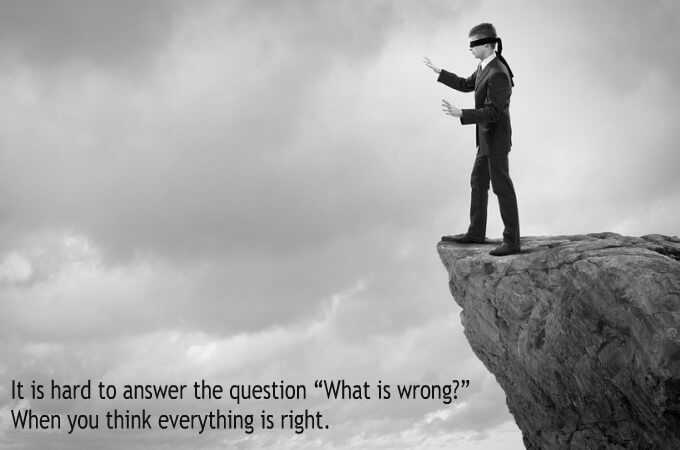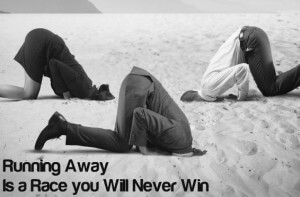Not long ago I met a newly promoted manager, Dave. He was, by all accounts, very effective and competent, but he had a blind spot. In his mind, he was also a great leader, and his goal was to develop his people to achieve their goals and grow. In the eyes of his direct reports, he was a selfish, slave driver and uncompassionate individual.
 Dave thought was doing them a favor by challenging them and giving them all the work they could handle for, in his mind that was a great way to develop them. He didn’t know that his behavior had the opposite effect he wanted – that was his blind spot. After all, the manager is the biggest driver of employee engagement, and despite Dave’s “efforts” his team was totally unengaged.
Dave thought was doing them a favor by challenging them and giving them all the work they could handle for, in his mind that was a great way to develop them. He didn’t know that his behavior had the opposite effect he wanted – that was his blind spot. After all, the manager is the biggest driver of employee engagement, and despite Dave’s “efforts” his team was totally unengaged.
We all have blind spots – unproductive behaviors that are invisible to us but glaringly obvious to everyone else. I have seen blind spots work “their magic” in many people. For example have you noticed that when you bring up something or suggest an improvement to your manager, their first response feels like a reflex?
A reflex, apparently not well thought out, and their response often starts in one of two ways:
A) “Yes, but…” When we start a sentence with this opening or a variation thereof, no matter how friendly your tone or how many mollifying phrases you throw in to acknowledge the other person’s feelings, the message to the other person is: You are wrong. And, of course, this will also demoralize employees, and that kills employee engagement.
B) “Let me tell you why this won’t work.” This is a classic response of negativity; it is more common than you think. It is annoying because we are sharing our unsolicited negativity under the guise of being helpful. This will kill employee engagement, and people will not be willing to find solutions if their manager is going to let them know why their ideas won’t work the minute they bring them to the table. This behavior is serious; it matters to people, and it is a problem.
The above two cases are simple examples of blind spots. Marshall Goldsmith has made a career helping leaders to discover their blind spots and assist them to deal with them. We all have them, and they are weaknesses we must combat.
Why does it matter knowing your blind spots? Because it is a necessary part of our growth as leaders. Identifying them, understanding them, seeing the effect that they have on our team, heightens the level of self-awareness. If we were to do something about addressing our blind spots, the result is a faster progression toward achieving our standard of leadership effectiveness. Getting a leadership coach is an excellent way to uncover our blind spots so that we can become better.
 Let’s be clear, blind spots aren’t necessarily negative traits or weaknesses, although they usually are. However, when you are unaware of a behavior of yours that is affecting your performance as an entrepreneur, there is a high likelihood that it is acting as an invisible (to you at least) obstacle that limits your effectiveness in how others see you as a leader. When you uncover your blind spots (by yourself or with the help of a coach) and actively work to address them, you start becoming more aware of your strengths and opportunity areas. If you don’t uncover these blind spots, you will never be able to improve on them, simply because you aren’t aware that they exist.
Let’s be clear, blind spots aren’t necessarily negative traits or weaknesses, although they usually are. However, when you are unaware of a behavior of yours that is affecting your performance as an entrepreneur, there is a high likelihood that it is acting as an invisible (to you at least) obstacle that limits your effectiveness in how others see you as a leader. When you uncover your blind spots (by yourself or with the help of a coach) and actively work to address them, you start becoming more aware of your strengths and opportunity areas. If you don’t uncover these blind spots, you will never be able to improve on them, simply because you aren’t aware that they exist.
Dave, newly promoted, was with the help of a leadership coach, was able to see the disconnection between his goal and his actions and most importantly, the effect that his behavior had on his team. He was able to work on his blind spot and develop his team the way he originally intended. His team was involved in his change and their perception changed with his behavior. A win – win situation.
Blind spots are often ignored, by the leader who has them (obviously), but they are present. In good times blind spots are annoying and frustrating; in tough times, they can be lethal. You can’t do much about your blind spots until you can recognize that they are there.
How do you know you have them? – Ask others for their candid feedback. Then, take accountability for your impact and stop justifying your behavior by defending your positive intentions. Finally, you might want to invest in a leadership coach that will help you change that particular behavior. Finally, once you identify your blind spot, stop the behavior on its tracks, it will make you a much better leader.
___________
Interested in finding more about our process of Leadership Coaching that will help any executive to deal with their blind spots? Please Send us an email right away; we will reply within 24 hours.
